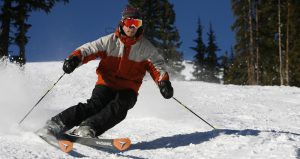 Alpine and Nordic skiing, as well as snowboarding are very popular winter sports. Millions of people hit the slopes each year. With proper precautions injuries on the ski slopes can be prevented. The current statistics for Alpine skiing injuries is 2.63 skier injuries for every 1,000 skier visits. Snowboarders are injured at a higher rate of 3.37 injuries per 1,000 visits. Although much less dangerous Nordic skiing can still cause injuries if the proper injury prevention measures are not utilized.
Alpine and Nordic skiing, as well as snowboarding are very popular winter sports. Millions of people hit the slopes each year. With proper precautions injuries on the ski slopes can be prevented. The current statistics for Alpine skiing injuries is 2.63 skier injuries for every 1,000 skier visits. Snowboarders are injured at a higher rate of 3.37 injuries per 1,000 visits. Although much less dangerous Nordic skiing can still cause injuries if the proper injury prevention measures are not utilized.
Alpine Skiing and Snowboarding
The number one thing that can be done for skiing or snowboarding injury prevention is a good preseason training program. People that attempt to hit the slopes while out of shape are at a much greater risk of injury because most injuries are caused by exhaustion. The most common times of day to get injured are at the end of the day or before lunch. Aerobic endurance is important so you don’t get tired, causing injury. If you are not currently involved in an aerobic fitness program you need to give yourself at least 6 weeks before the season starts to get into ski/snowboard shape. Speed and agility training is also a strong recommendation to include in a training program. Some great aerobic endurance fitness activities include biking, running, swimming, and the elliptical. Remember if you do start to feel tired while on the slopes take a break to avoid injury.
Not only is fitness important, but stretching before and after skiing or snowboarding can cut down on the injuries. Stretching before you begin will help to improve your range of motion. After completing your ski or snowboard session stretch once again to help your muscles return to their normal length. Connective tissue shortens over time and stretching can help maintain good alignment in the bones.
Lessons are another great way to prevent injury. Intermediate and advanced lessons are important for skiers to help with technique. It’s a bad idea to only get a beginner lesson and never work on a more advanced skiing form as you improve. If you notice that you are becoming fatigued too easily while skiing or snowboarding it might be a sign that you should take more lessons.
Having the correct skiing and snowboarding equipment is also very important. A helmet is a must for snowboarding or alpine skiing. A helmet will help prevent a head injury during an accident. At crowded ski resorts it is hard to control what other people are doing on the hill, so a helmet will also be able to help you out if another person on the hill crashes into you. Also make sure that the skis, boots, and bindings that you are wearing are right for your height and skill level. In order to prevent a broken wrist always wear a wrist guard while snowboarding.
Around 85% of alpine skiing/snowboarding related injuries occur from falling while traveling down the hill or loss of control during a jump. Fortunately for skiers modern releasable bindings have reduced skiing fractures by 90%, in the past 30 years. Knee injuries are the most common for alpine skiers and wrist injuries are the most common for snowboarders. Alpine skiing and snowboarding has a reputation for causing injuries, but runners get injured more often. Although when skiers or snowboarders do get injured it is usually more catastrophic than a running injury.
Nordic Skiing
Nordic skiing is a great full body workout. Although Nordic skiing is safer than alpine skiing injuries still do occur, most of these injuries are from overuse. The most common areas that injuries occur are in the lower back, knee, and shoulder.
Training error is the main cause of injury. This occurs when you do too much to soon. Having a great skiing technique can help to prevent injury. Taking a cross-country skiing lesson can help you to prefect your technique. The more you Nordic ski the less likely you are to get injured.
If you do get injured while skiing or snowboarding physical or occupational therapy is a great option for recovery. Working with a therapist can help you make a full and quicker recovery to get back out in the snow as soon as possible.
